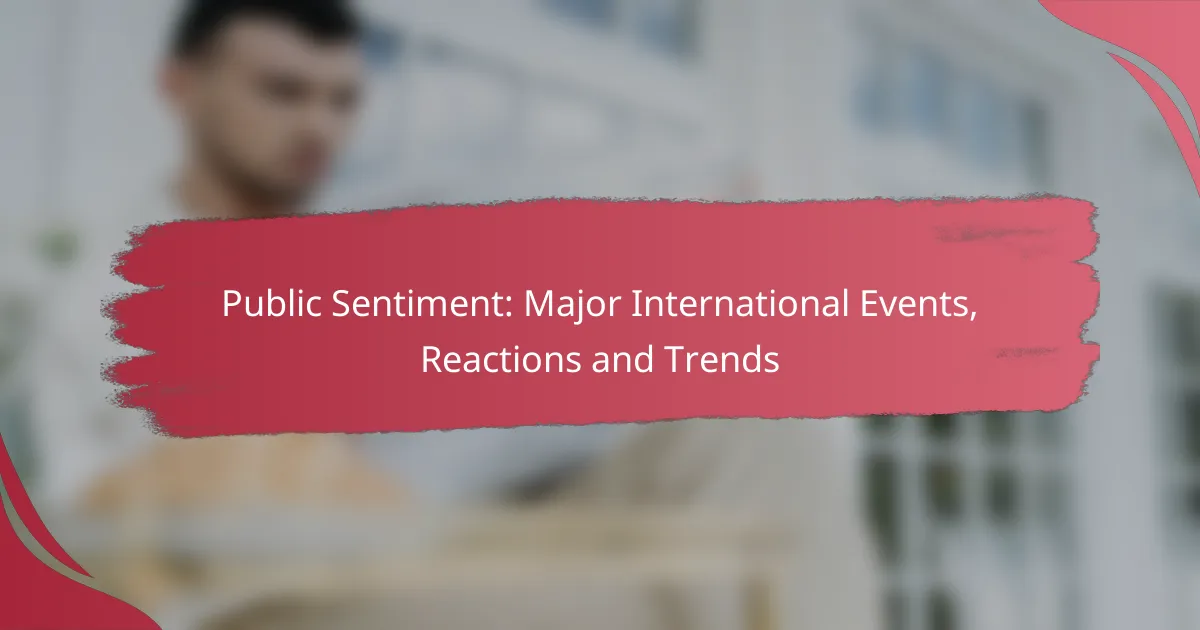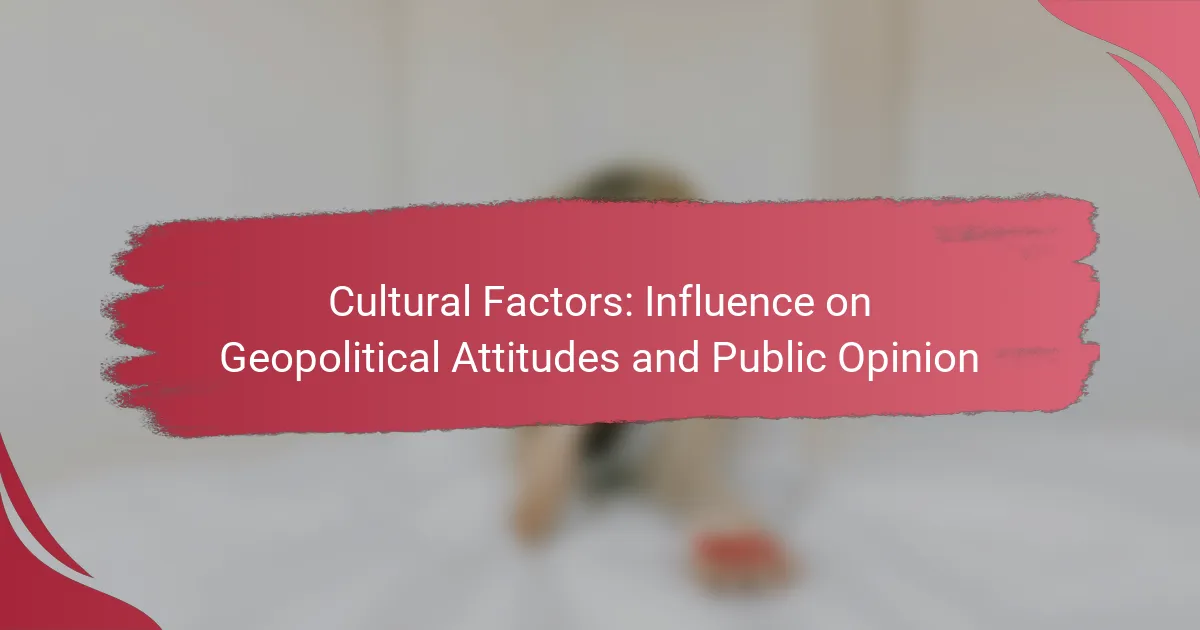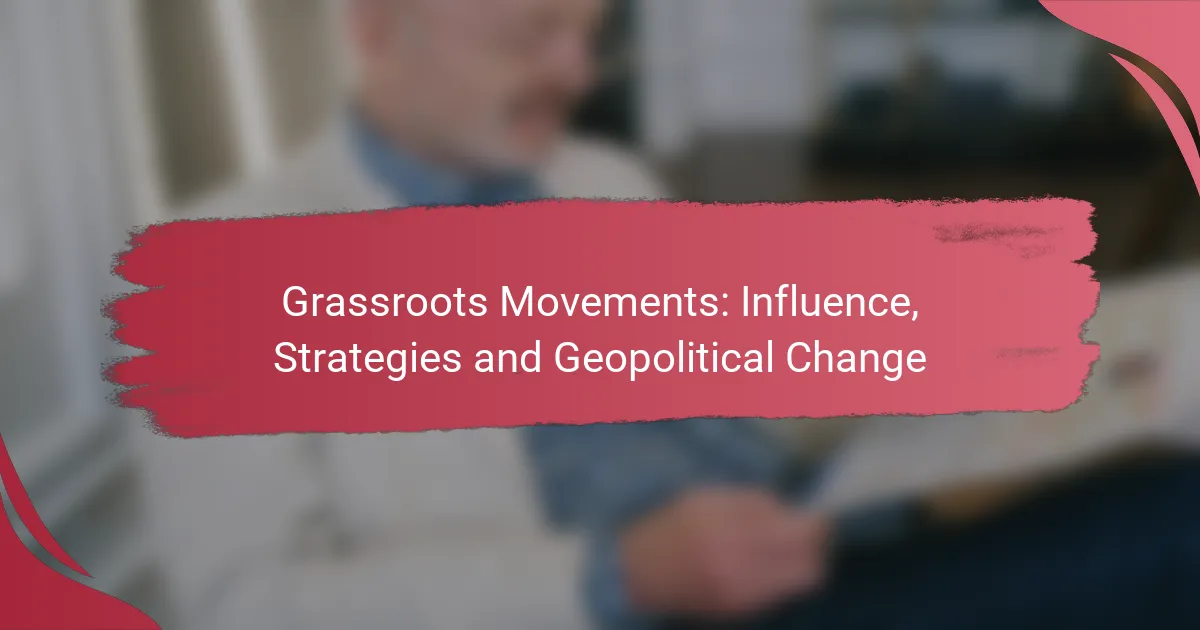Major international events play a crucial role in shaping public sentiment, influencing perceptions and behaviors across diverse populations. These occurrences often trigger emotional responses and can lead to significant shifts in attitudes toward pressing issues such as politics, health, and social justice. By analyzing public sentiment through surveys and social media, we can gain valuable insights into how these events affect collective opinions and priorities.
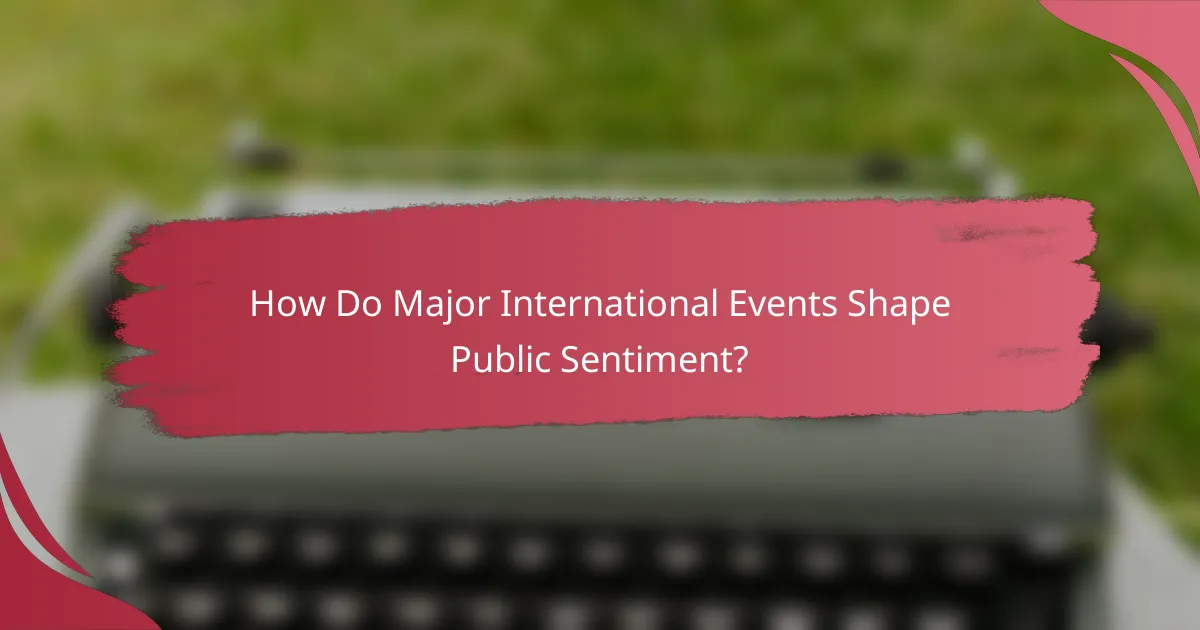
How Do Major International Events Shape Public Sentiment?
Major international events significantly influence public sentiment by altering perceptions, attitudes, and behaviors across different populations. These events can evoke strong emotional responses and reshape opinions on various issues, from politics to social justice.
Impact of Global Crises
Global crises, such as pandemics or natural disasters, often lead to heightened public concern and urgency. For instance, the COVID-19 pandemic shifted public sentiment towards prioritizing health and safety, influencing behaviors like mask-wearing and vaccination uptake.
These crises can also foster solidarity or division, depending on how governments and communities respond. Effective crisis management may enhance trust in leadership, while poor responses can lead to widespread dissatisfaction and protest.
Influence of Political Decisions
Political decisions, such as new legislation or international treaties, can significantly sway public sentiment. For example, a government’s stance on climate change can mobilize public support or opposition, depending on the perceived effectiveness of the policies implemented.
Voter sentiment often shifts in response to political events, such as elections or referendums, reflecting the public’s approval or disapproval of current leadership and policies. This sentiment can be crucial during election cycles, influencing voter turnout and party support.
Cultural Events and Public Reaction
Cultural events, including festivals, sports competitions, or art exhibitions, can evoke strong public reactions that shape sentiment. For instance, a successful Olympic Games can foster national pride and unity, while controversies surrounding such events may lead to public backlash.
These events often serve as a reflection of societal values and can catalyze discussions on important issues, such as diversity and inclusion, further influencing public opinion.
Media Coverage Effects
Media coverage plays a critical role in shaping public sentiment by framing narratives around major events. The way news outlets report on issues can amplify certain perspectives, influencing how the public perceives the significance of those events.
For example, extensive coverage of a humanitarian crisis can lead to increased public empathy and calls for action, while sensationalized reporting may provoke fear or anger. Understanding media bias is essential for consumers to critically assess the information presented.
Social Media Trends
Social media trends can rapidly shift public sentiment by facilitating the spread of information and opinions. Platforms like Twitter and Facebook allow users to share their reactions to events in real-time, often amplifying voices that may be marginalized in traditional media.
Viral hashtags and movements can mobilize public support for causes, influencing perceptions and actions. However, misinformation can also spread quickly, leading to confusion and polarized opinions, making media literacy crucial for navigating these platforms effectively.

What Are Recent Examples of Public Sentiment Shifts?
Recent public sentiment shifts have been significantly influenced by global events, reflecting changing attitudes and priorities among populations. Key areas of focus include health crises, environmental concerns, international conflicts, and social justice issues.
COVID-19 Pandemic Reactions
The COVID-19 pandemic triggered a dramatic shift in public sentiment towards health and safety. Initially, there was widespread support for lockdowns and health measures, but as time progressed, sentiments shifted towards frustration over restrictions and a desire for normalcy.
Public opinion varied significantly across regions, with some countries prioritizing strict measures while others opted for more lenient approaches. This divergence often reflected cultural attitudes towards government intervention and personal freedoms.
Climate Change Protests
Climate change protests have gained momentum, showcasing a growing public urgency for action against environmental degradation. Movements like Fridays for Future and Extinction Rebellion have mobilized millions, particularly among younger demographics, demanding immediate governmental response.
These protests highlight a shift in sentiment where climate action is increasingly viewed as a moral imperative. Many participants advocate for policies that prioritize sustainability and renewable energy, often calling for significant changes in corporate practices and governmental regulations.
Geopolitical Conflicts
Geopolitical conflicts, such as the war in Ukraine, have significantly influenced public sentiment, particularly regarding national security and foreign policy. Many citizens express heightened concern about military involvement and the implications of international alliances.
Public reactions often vary based on national interests and historical contexts, leading to polarized views on issues like sanctions and refugee policies. This shift in sentiment can affect electoral outcomes and influence governmental strategies in foreign relations.
Social Justice Movements
Social justice movements have seen a resurgence, with public sentiment increasingly favoring equity and inclusion. Movements like Black Lives Matter and #MeToo have sparked widespread discussions about systemic racism and gender inequality, leading to calls for legislative reforms.
These movements have shifted public perception, making issues of justice and equality central to political discourse. Many advocate for comprehensive policy changes, emphasizing the need for accountability and systemic change in institutions.
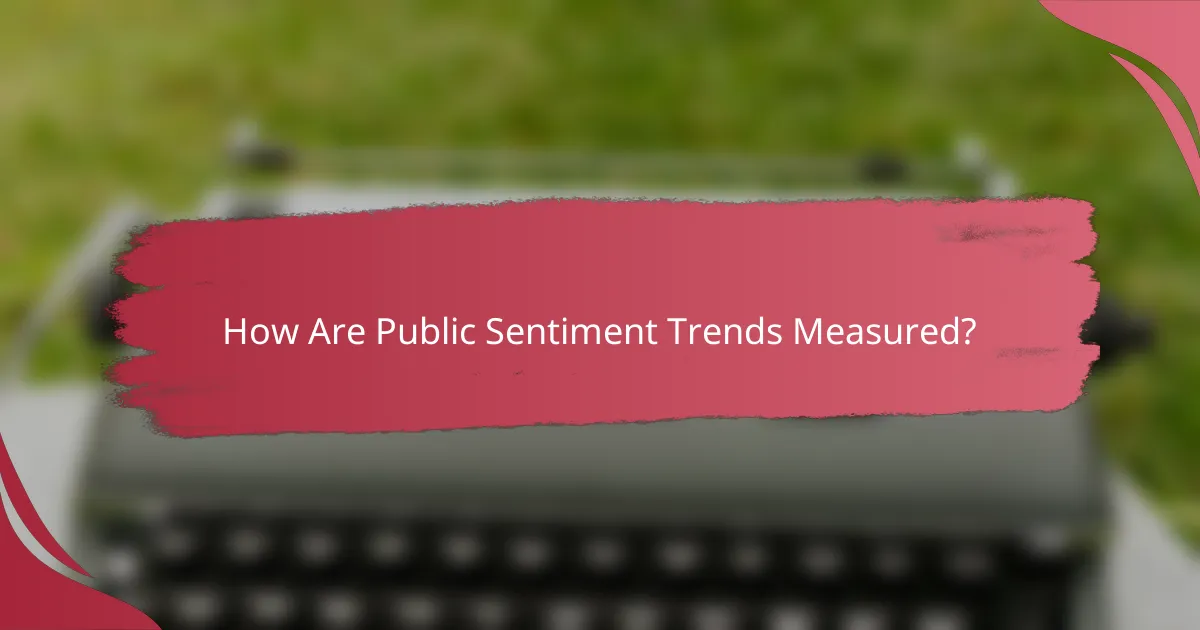
How Are Public Sentiment Trends Measured?
Public sentiment trends are typically measured through various methods that capture opinions and emotions of individuals regarding significant events. These methods include surveys, social media analytics, and sentiment analysis tools, each offering unique insights into public attitudes.
Surveys and Polls
Surveys and polls are direct methods for gauging public sentiment, often conducted by research organizations or media outlets. They typically involve asking a representative sample of individuals their opinions on specific issues or events, using structured questionnaires.
When designing surveys, it’s crucial to ensure questions are clear and unbiased to avoid skewed results. Polls can be conducted online, via phone, or in person, with response rates varying widely, often ranging from 5% to 30% depending on the method and topic.
Social Media Analytics
Social media analytics involves monitoring platforms like Twitter, Facebook, and Instagram to assess public sentiment in real-time. By analyzing posts, comments, and shares, organizations can gauge how people feel about specific events or trends.
Key metrics include engagement rates, sentiment scores, and trending hashtags. Tools like Hootsuite or Sprout Social can help track these metrics, allowing for quick adjustments in communication strategies based on public reactions.
Sentiment Analysis Tools
Sentiment analysis tools use natural language processing to evaluate text data from various sources, determining whether the sentiment expressed is positive, negative, or neutral. These tools can analyze large volumes of data quickly, making them valuable for understanding public sentiment trends.
Popular sentiment analysis tools include IBM Watson and Google Cloud Natural Language. While these tools can provide insights, it’s essential to remember that they may not always capture nuances in human emotion, so combining them with qualitative methods can enhance accuracy.
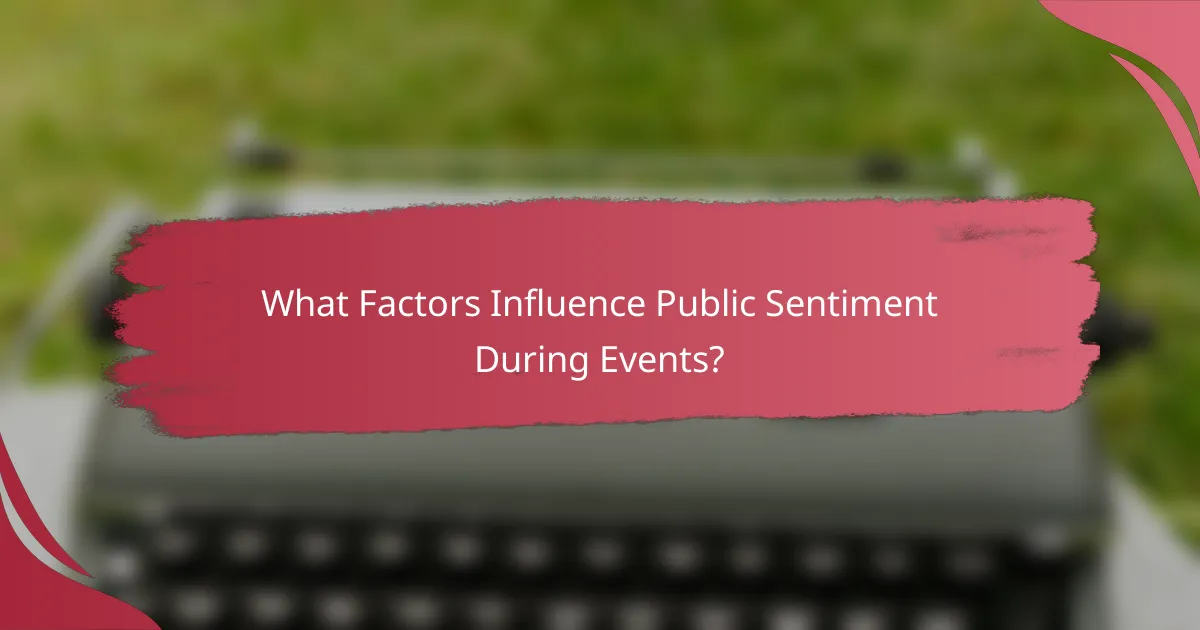
What Factors Influence Public Sentiment During Events?
Public sentiment during major international events is shaped by various factors, including media coverage, statements from public figures, and community engagement. These elements can significantly sway public opinion and emotional responses, often leading to widespread reactions.
Media Influence
The media plays a crucial role in shaping public sentiment by framing events and providing context. Coverage can vary widely, from sensationalized reporting to more balanced perspectives, affecting how the public perceives the event. For instance, extensive coverage of a humanitarian crisis can lead to increased empathy and support for aid efforts.
Additionally, the medium of communication matters; social media can amplify certain narratives quickly, while traditional news outlets may provide more in-depth analysis. Understanding the source and tone of media coverage is essential for interpreting public sentiment accurately.
Public Figures’ Statements
Statements from influential public figures, such as politicians, celebrities, or activists, can significantly impact public sentiment. Their endorsements or criticisms can validate or challenge prevailing opinions, often leading to shifts in how the public feels about an event. For example, a politician’s call for action in response to a crisis can mobilize supporters and change the discourse.
Moreover, the timing and delivery of these statements are critical. Immediate reactions may resonate more with the public, while delayed responses can be perceived as indifference. Engaging with public figures’ communications can provide insights into broader societal attitudes.
Community Engagement
Community engagement is vital in shaping public sentiment, as local responses often reflect broader societal feelings. Grassroots movements, local organizations, and community discussions can foster a sense of solidarity and collective action. For instance, community-led initiatives in response to an international event can galvanize support and influence public opinion.
Participation in community forums or social media groups can help individuals feel more connected and informed about the sentiments surrounding an event. Encouraging open dialogue within communities can lead to a more nuanced understanding of public sentiment and its implications.
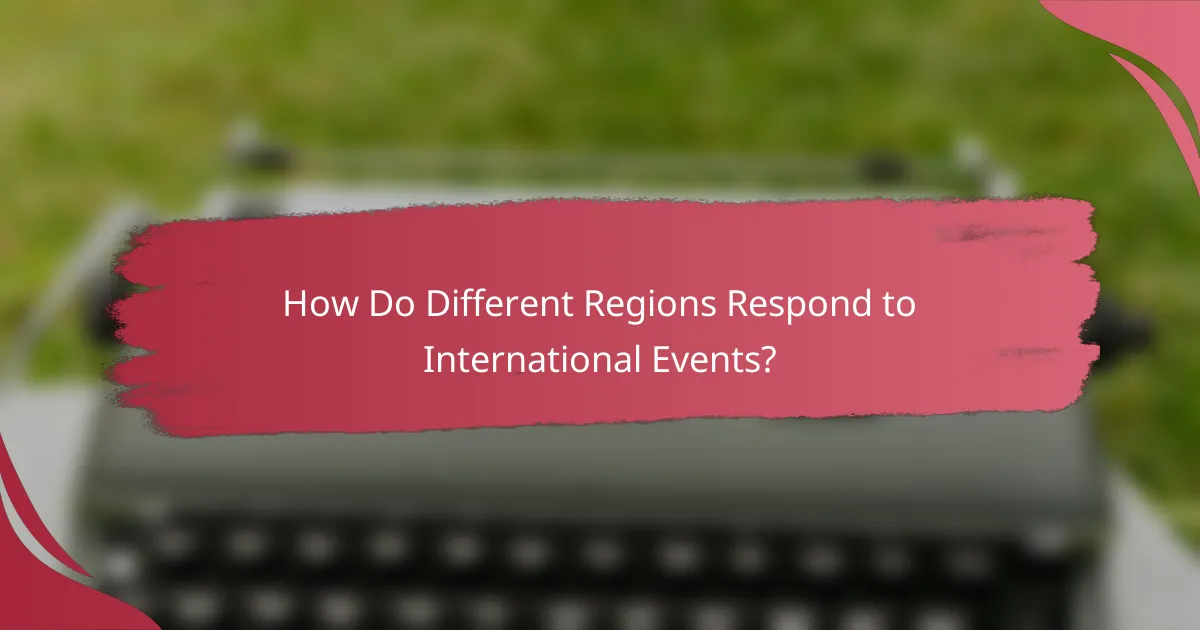
How Do Different Regions Respond to International Events?
Different regions exhibit distinct reactions to international events, shaped by cultural, political, and economic factors. Understanding these regional responses can provide insights into global public sentiment and influence diplomatic relations.
North America Reactions
In North America, public reactions to international events often reflect a mix of individualism and collective sentiment. For instance, major events like conflicts or humanitarian crises typically prompt a strong response from both the government and the public, with calls for action or support for affected populations.
Social media plays a significant role in shaping these reactions, allowing for rapid dissemination of information and mobilization of public opinion. Campaigns for humanitarian aid or political action often gain traction quickly, reflecting a proactive engagement with global issues.
European Perspectives
European public sentiment towards international events is frequently influenced by historical ties and regional integration. The European Union’s collective stance on issues such as climate change or geopolitical conflicts often reflects a desire for unity and shared responsibility among member states.
Public opinion in Europe can vary significantly between countries, with Northern and Southern nations sometimes holding contrasting views on issues like immigration or military intervention. Polling data often reveals these differences, highlighting the importance of local context in understanding European reactions.
Asian Public Sentiment
In Asia, public sentiment towards international events is shaped by diverse cultural and political landscapes. Countries like Japan and South Korea may respond to global crises with a focus on technological solutions and humanitarian aid, while nations like China may emphasize national sovereignty and economic interests.
Regional dynamics, such as historical conflicts or economic partnerships, heavily influence public reactions. For example, responses to international trade agreements can vary widely, with some nations embracing globalization while others advocate for protectionist measures.
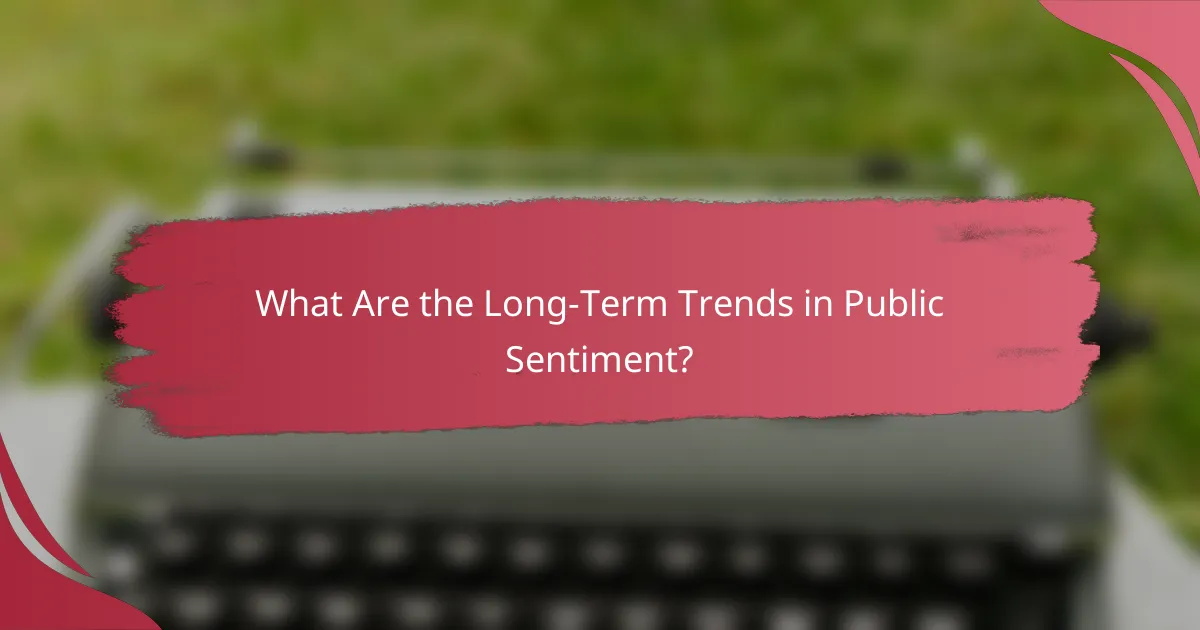
What Are the Long-Term Trends in Public Sentiment?
Long-term trends in public sentiment often reflect shifts in societal values, political landscapes, and global events. These trends can be influenced by factors such as economic conditions, cultural movements, and significant international occurrences.
Shifts in Political Sentiment
Political sentiment has evolved significantly over the years, often swaying in response to major events like elections, policy changes, or international conflicts. For instance, public opinion can shift dramatically following a controversial election or a significant legislative reform, reflecting the electorate’s changing priorities.
To understand these shifts, it’s essential to monitor opinion polls and surveys that gauge public attitudes toward political figures and policies. Engaging with diverse media sources can also provide insights into the prevailing political climate and its impact on public sentiment.
Impact of Economic Factors
Economic conditions play a crucial role in shaping public sentiment. During periods of economic growth, people tend to express more positive sentiments, while economic downturns often lead to increased dissatisfaction and concern. For example, high unemployment rates or inflation can lead to widespread frustration and anxiety among the populace.
Tracking economic indicators such as GDP growth, unemployment rates, and consumer confidence can help predict shifts in public sentiment. Understanding these economic trends allows for better anticipation of public reactions to government policies and initiatives.
Cultural and Social Movements
Cultural and social movements significantly influence public sentiment by raising awareness and shifting perceptions on various issues. Movements advocating for social justice, environmental protection, or public health can lead to lasting changes in public attitudes and behaviors.
Engaging with social media platforms and community discussions can provide valuable insights into these movements and their impact on public sentiment. Observing how these movements resonate with different demographics can also highlight generational differences in attitudes and beliefs.
Global Events and Their Influence
Major international events, such as pandemics, wars, or climate crises, can have profound effects on public sentiment worldwide. These events often lead to increased solidarity or division among populations, shaping how communities perceive their governments and each other.
Monitoring global news and analyzing public reactions to international crises can help gauge shifts in sentiment. Understanding the emotional responses to these events can inform policymakers and organizations on how to address public concerns effectively.
